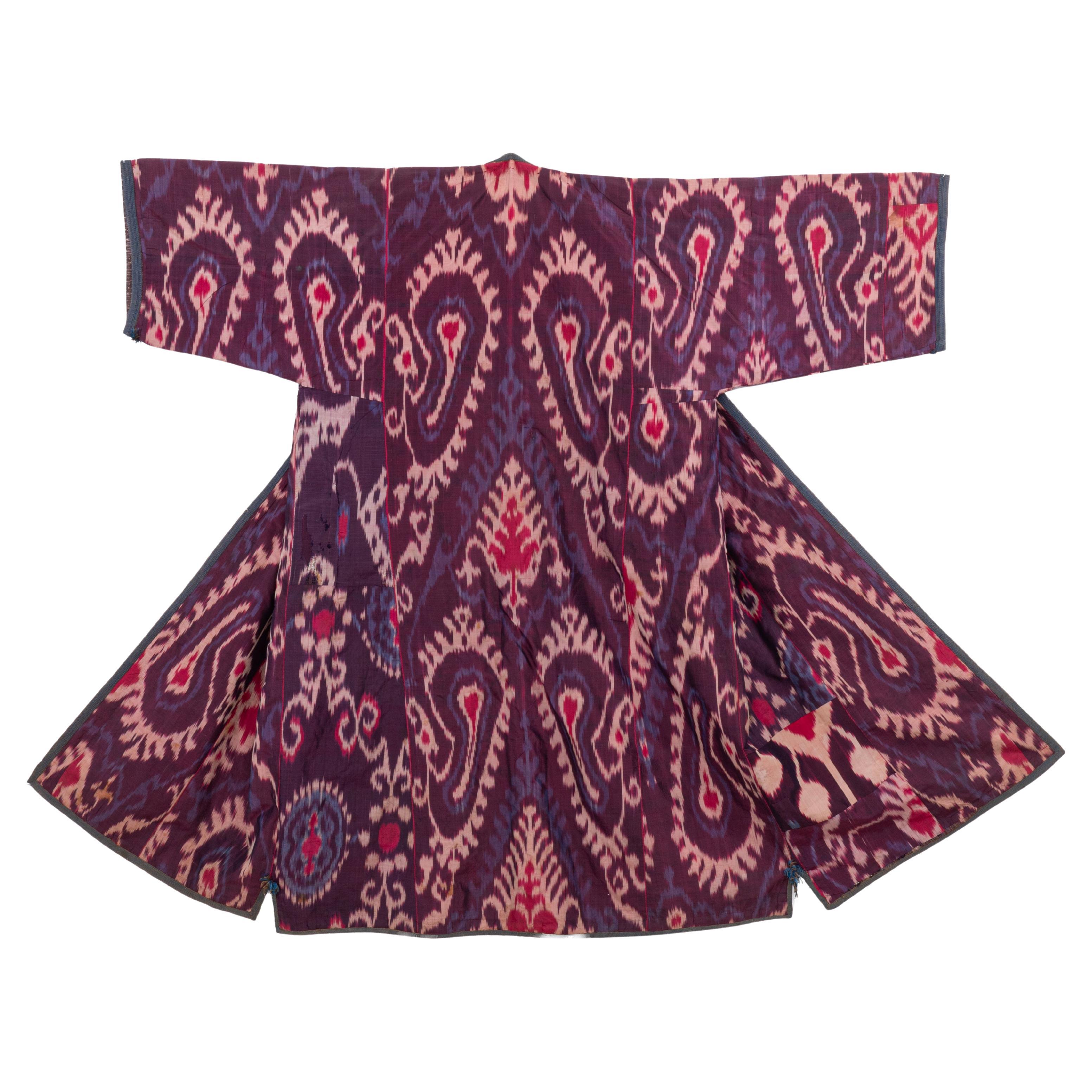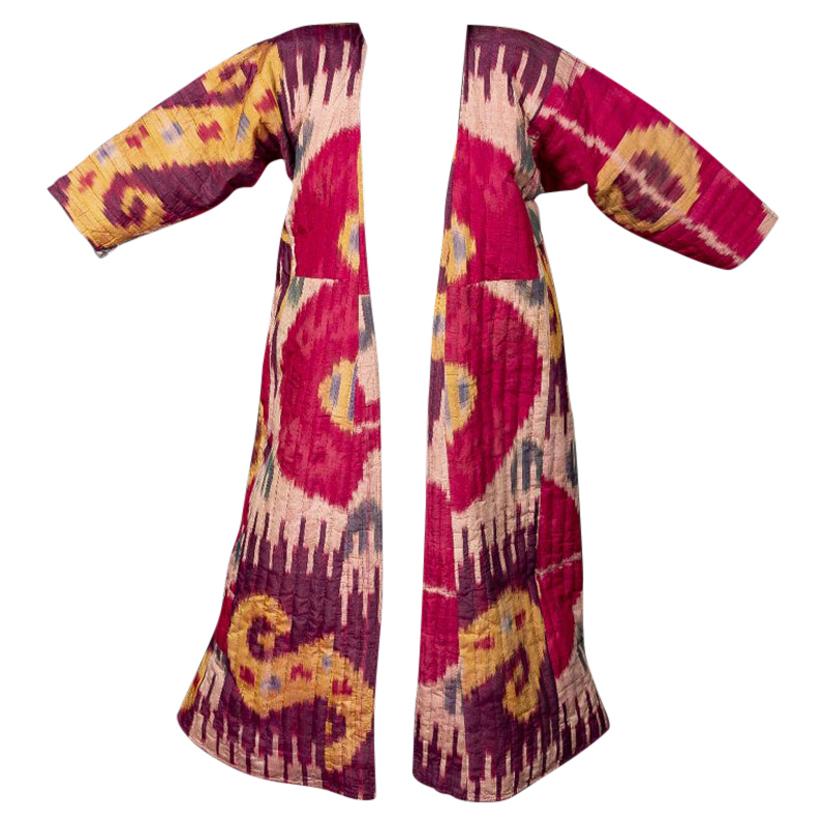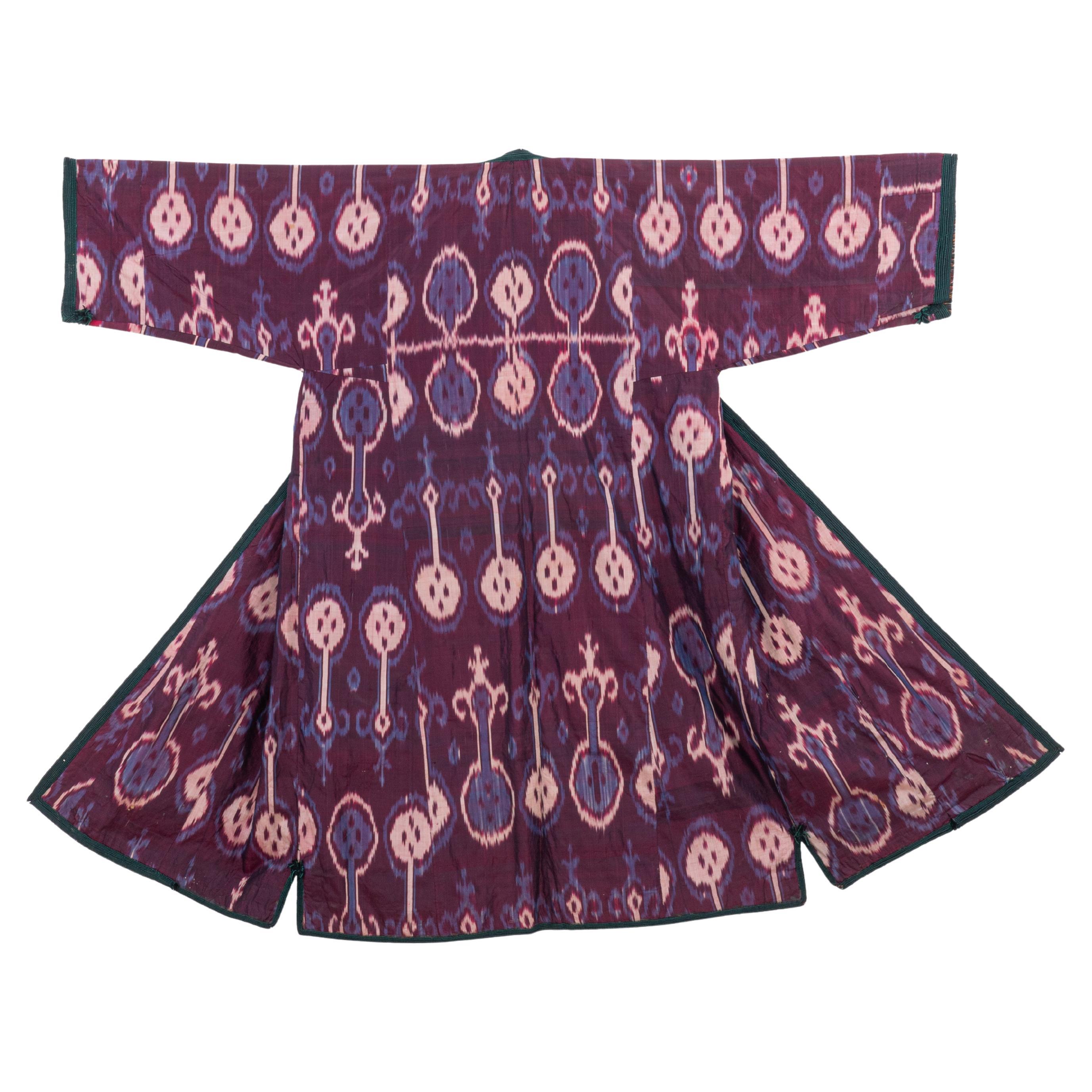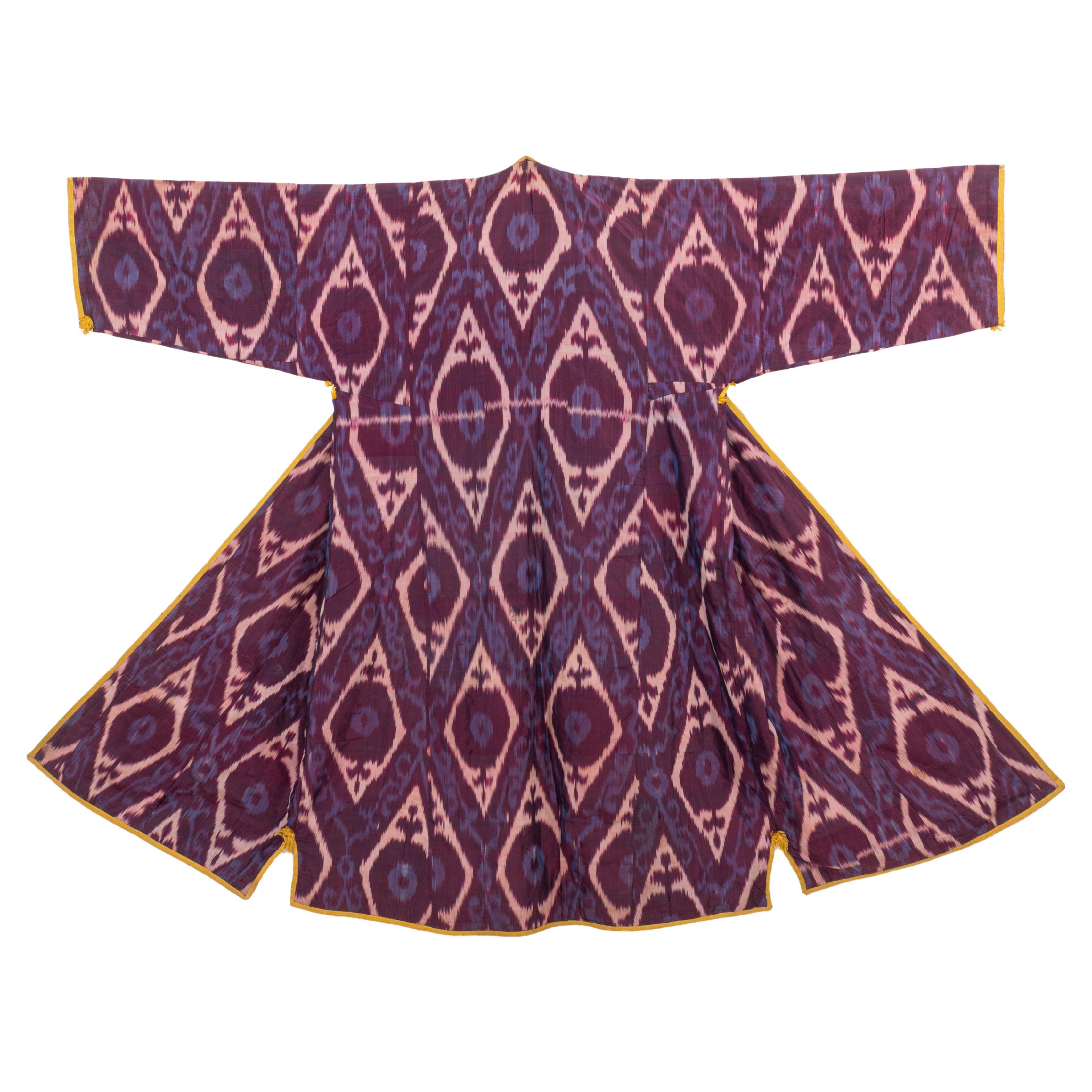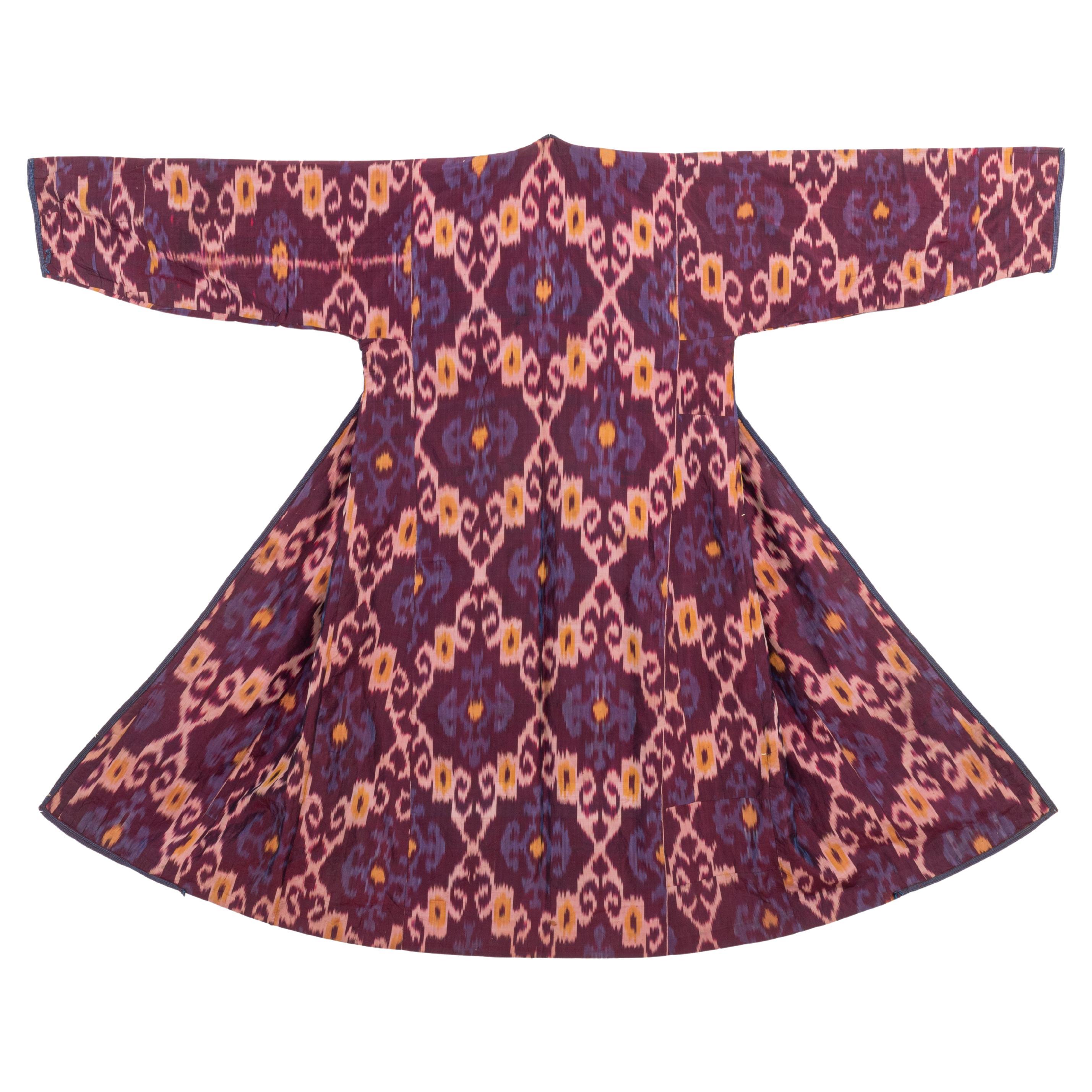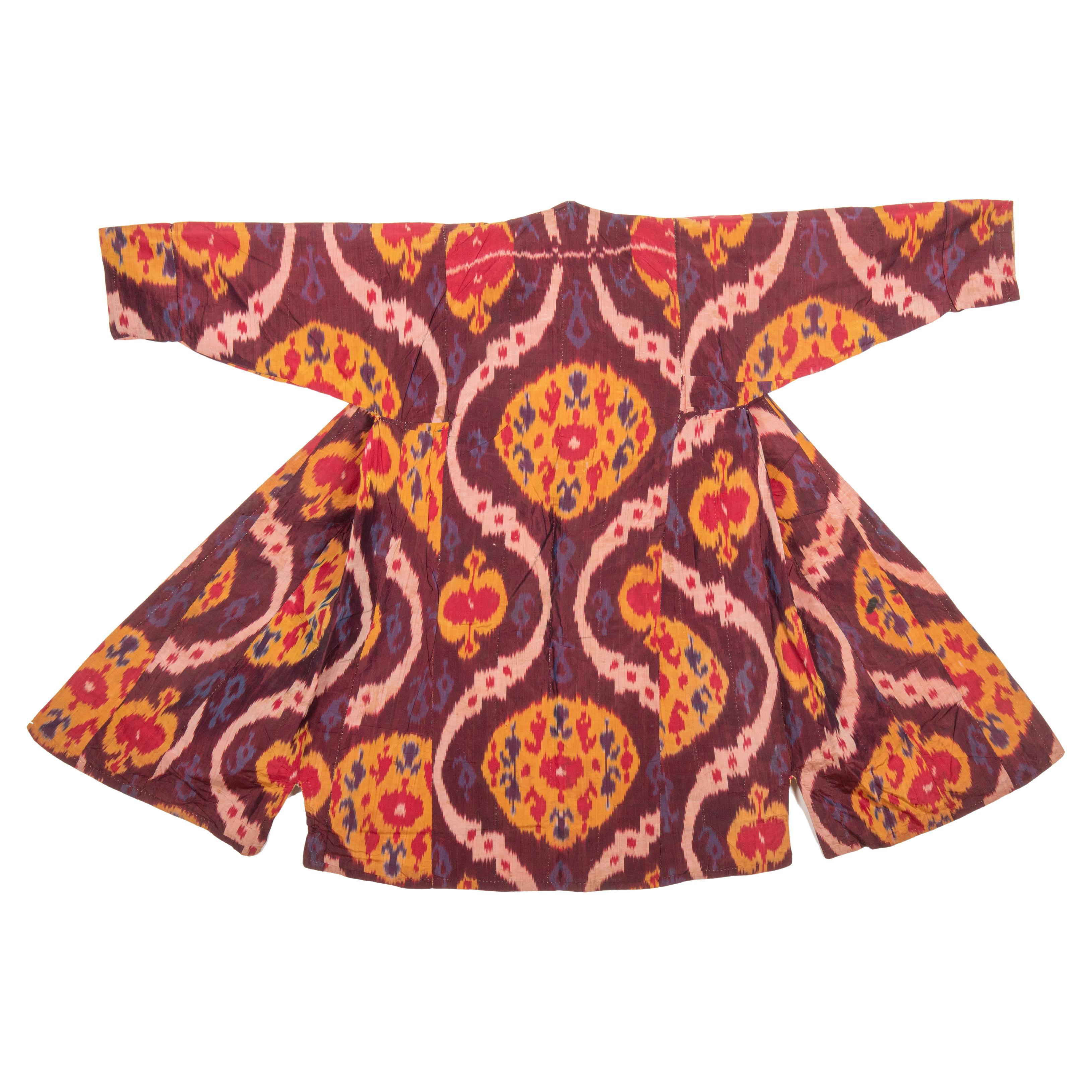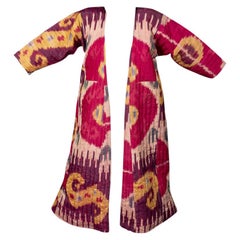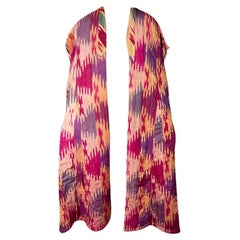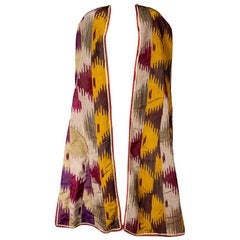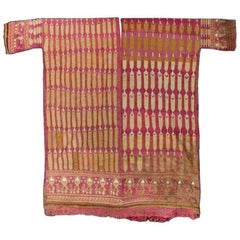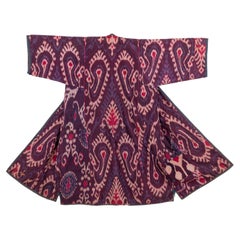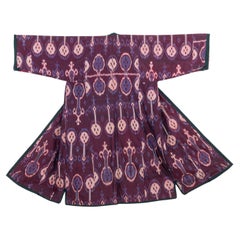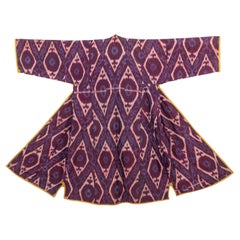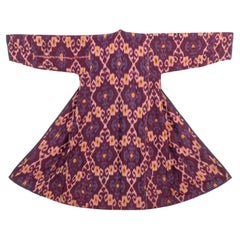Items Similar to Magnificent Silk Ikat Chapan, Uzbekistan, Xix Century
Want more images or videos?
Request additional images or videos from the seller
1 of 8
Magnificent Silk Ikat Chapan, Uzbekistan, Xix Century
$1,450
£1,096.02
€1,259.52
CA$2,019.12
A$2,246.18
CHF 1,177.48
MX$27,447.82
NOK 14,993.71
SEK 14,114.50
DKK 9,401.86
Shipping
Retrieving quote...The 1stDibs Promise:
Authenticity Guarantee,
Money-Back Guarantee,
24-Hour Cancellation
About the Item
Ikat Chapan – a man’s uzbek coat – Style Robe with exceptionally rich colour and dynamic pattering. Viewers may become lost in this ikat’s intertwining motifs, but it is colour that truly entrances them. Each unique ikat is the work of an individual who thought deeply about his every choice of colour and form in order to build a harmonious composition. There is always a concern with negative and positive space, for the placement of each pattern and its corollary. We can see the risks that the anonymous ikat designers took and trace their response to each step of the dyeing process. In their way, each ikat is a discovery of a new kind of order,
Ca. 19th century
Ikat weaving has emerged from different parts of the world independently, however it is ikat from Uzbekistan, defined as abrabandi, meaning “bound cloud” which is the most captivating. The word ‘ikat’ comes from the Malaysian word ‘mengikat’ or ‘to tie’, because the loose threads are tied into bundles using grasses or wax-treated cotton to specify where the dye is able to sink in and color the thread. The threads are dyed before they are woven into the textiles.
A characteristic of ikat textiles is an apparent “blurriness” to the design. The blurriness is a result of the extreme difficulty the weaver has lining up the dyed yarns so that the pattern comes out perfectly in the finished cloth. The blurriness can be reduced by using finer yarns or by the skill of the craftsperson. Ikats with little blurriness, multiple colours and complicated patterns are more difficult to create and therefore often more expensive. However, the blurriness that is so characteristic of ikat is often prized by textile collectors.
The Silk Road was a network rather than a single highway, at the heart of which sat what we know today as Uzbekistan, where mountain and steppe meet desert. A succession of empires lost and won by nomadic invaders have left behind a unique melting pot of cultures. Merchants, pilgrims, and envoys were attracted here, not only by trade but also by exchanges in religion, technology and the arts. Where these people met, so too did their ideas and their creativity, one of the most original and visually dramatic examples of Central Asian silk. The clarity, saturation and depth of colour in classical ikats are their greatest artistic strengths. The eye is teased, tickled by the sophistication of the composition and the elegance of the forms.
Measurements: 123 x 122 cm.
- Dimensions:Height: 48.42 in (122.99 cm)Width: 48.03 in (122 cm)Depth: 1 in (2.54 cm)
- Materials and Techniques:
- Place of Origin:Uzbekistan
- Period:
- Date of Manufacture:19th Century
- Condition:
- Seller Location:San Pedro Garza Garcia, MX
- Reference Number:1stDibs: LU3172324337822
About the Seller
3.7
Vetted Professional Seller
Every seller passes strict standards for authenticity and reliability
1stDibs seller since 2017
24 sales on 1stDibs
Typical response time: 1 to 2 days
- ShippingRetrieving quote...Shipping from: San Pedro Garza Garcia, Mexico
- Return Policy
Authenticity Guarantee
In the unlikely event there’s an issue with an item’s authenticity, contact us within 1 year for a full refund. DetailsMoney-Back Guarantee
If your item is not as described, is damaged in transit, or does not arrive, contact us within 7 days for a full refund. Details24-Hour Cancellation
You have a 24-hour grace period in which to reconsider your purchase, with no questions asked.Vetted Professional Sellers
Our world-class sellers must adhere to strict standards for service and quality, maintaining the integrity of our listings.Price-Match Guarantee
If you find that a seller listed the same item for a lower price elsewhere, we’ll match it.Trusted Global Delivery
Our best-in-class carrier network provides specialized shipping options worldwide, including custom delivery.More From This Seller
View AllBeautiful Ikat Munisak, Uzbekistan, 19th Century
Located in San Pedro Garza Garcia, Nuevo Leon
A beautiful Ikat Munisak – a woman’s uzbek robe – in traditional pomegranate design symbolizing fertility. It has a square patch in Magenta with a flower mo...
Category
Antique 15th Century and Earlier Asian Antiquities
Materials
Cotton
Ikat Chyrpy, Central Asia
Located in San Pedro Garza Garcia, Nuevo Leon
Striking hand-woven chyrpy with a checkered triangle pattern in vibrant colours. Women in Uzbekistan and Northern Afghanistan wore this outdoor veiling garment (paranja/chrypy) in tr...
Category
Antique 15th Century and Earlier Asian Antiquities
Materials
Cotton
Ikat Chyrpy, Central Asia
Located in San Pedro Garza Garcia, Nuevo Leon
Spectacular hand-loomed Chyrpy with a checkered pattern, finished with a remarkable white wavy cotton edging. Women in Uzbekistan and Northern Afghanistan wore this outdoor veiling g...
Category
Antique 15th Century and Earlier Asian Antiquities
Materials
Cotton
Masterpiece Complete Chimu Shirt with Feathered Motif
Located in San Pedro Garza Garcia, Nuevo Leon
An intact shirt with motif of rows of feathers in several shades of mustard yellow on a red ground, depicted as they would have been attached in rows in an actual feather textile.
Category
Antique 15th Century and Earlier Peruvian Pre-Columbian Antiquities
Materials
Textile
Pre-Columbian Nazca Cross-Patterned Textile, Peru, 300-600 AD, Ex-Sotheby's
Located in San Pedro Garza Garcia, Nuevo Leon
Complete Pre-Columbian Textile panel woven in plain weave with interlocking and alternating squares in bright shades, with elongated stepped diamonds, looped fringe on the short ends...
Category
Antique 15th Century and Earlier Pre-Columbian Antiquities
Pre-Columbian Mantle Kilim Type Tapisserie Multicolor Designs - Nazca 200-600 AD
Located in San Pedro Garza Garcia, Nuevo Leon
Beautiful Pre-columbian Mantle with a Central Kilim Type Tapisserie of Multicolor Designs with Priests Upraising their Arms Toward the Skies. It is surrounded by 2 Long Red Plain Cot...
Category
Antique 15th Century and Earlier Peruvian Pre-Columbian Antiquities
Materials
Textile
You May Also Like
Silk Ikat Chapan, Tajikstan, Late 19th Century.
Located in Istanbul, TR
Chapans are probably the most famous Central Asian fashion garments made from mostly ıkats, either pure silk and lined with cotton, or silk war and cotton weft , again with a cotton ...
Category
Late 20th Century Tajikistani Folk Art Pillows and Throws
Materials
Silk
Silk Ikat Chapan, Tajikstan, Late 19th Century.
Located in Istanbul, TR
Chapans are probably the most famous Central Asian fashion garments made from mostly ıkats, either pure silk and lined with cotton, or silk war and cotton weft , again with a cotton ...
Category
Antique Late 19th Century Tajikistani Folk Art Pillows and Throws
Materials
Silk
Silk Ikat Chapan, Tajikstan, Late 19th Century.
Located in Istanbul, TR
Chapans are probably the most famous Central Asian fashion garments made from mostly ıkats, either pure silk and lined with cotton, or silk war and cotton weft , again with a cotton ...
Category
Antique Late 19th Century Tajikistani Folk Art Pillows and Throws
Materials
Cotton, Silk
Silk Ikat Chapan, Tajikstan, Late 19th Century.
Located in Istanbul, TR
Chapans are probably the most famous Central Asian fashion garments made from mostly ıkats, either pure silk and lined with cotton, or silk war and cotton weft , again with a cotton ...
Category
Late 20th Century Tajikistani Folk Art Pillows and Throws
Materials
Cotton, Silk
Silk Ikat Chapan from Uzbekistan, Early 20th C
Located in Istanbul, TR
A Silk Ikat Chapan from Uzbekistan is a traditional robe or coat made of silk fabric, adorned with intricate ikat patterns. "Ikat" is a dyeing and weaving technique used to create un...
Category
Early 20th Century Uzbek Pillows and Throws
Materials
Silk
Silk and Cotton Ikat Chapan, Uzbekistan, Late 19th Century.
Located in Istanbul, TR
Chapans are probably the most famous Central Asian fashion garments made from mostly ıkats, either pure silk and lined with cotton, or silk war and cotton weft , again with a cotton ...
Category
Antique Late 19th Century Uzbek Folk Art Pillows and Throws
Materials
Cotton, Silk
